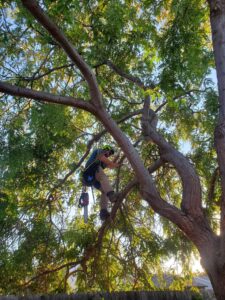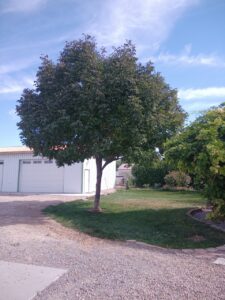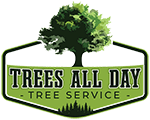Height Reduction Tree Pruning
 Sometimes there are reasons to reduce the height of a tree or reduce the crown. This should not be confused with the unacceptable practice of “topping” trees. Topping trees is the practice of cutting indiscriminately cutting the top portion of a tree off to reduce it’s height. After this is done the tree will respond with a massive amount of new shoot growth. This new shoot growth is weakly attached and can pose a significant risk of falling off in the future. This type of tree cutting will lead to the tree’s decline and eventual death. Trees All Day Tree service does not top trees this way.
Sometimes there are reasons to reduce the height of a tree or reduce the crown. This should not be confused with the unacceptable practice of “topping” trees. Topping trees is the practice of cutting indiscriminately cutting the top portion of a tree off to reduce it’s height. After this is done the tree will respond with a massive amount of new shoot growth. This new shoot growth is weakly attached and can pose a significant risk of falling off in the future. This type of tree cutting will lead to the tree’s decline and eventual death. Trees All Day Tree service does not top trees this way.
There are however some acceptable methods of crown reduction and height reduction that are not harmful to the tree if done correctly. The choice of method depends on several factors like the age of the tree, the goals of the owner, the species, and what has been done to the tree in the past.
Retrenchment Pruning
![]()
![]() Retrenchment pruning is a process of preserving mature
Retrenchment pruning is a process of preserving mature![]() trees that have problems with the upper crown. It is difficult for a tree to get water and minerals for photosynthesis to the upper crown especially when the tree is older. Because of this the tree will naturally tend to develop a lower canopy and the upper canopy will die back. As arborists we can help the tree accomplish this by reducing the upper crown slowly over time and allowing the lower crown to take over giving the older tree a fresh new crown that it can more easily supply with water and minerals.
trees that have problems with the upper crown. It is difficult for a tree to get water and minerals for photosynthesis to the upper crown especially when the tree is older. Because of this the tree will naturally tend to develop a lower canopy and the upper canopy will die back. As arborists we can help the tree accomplish this by reducing the upper crown slowly over time and allowing the lower crown to take over giving the older tree a fresh new crown that it can more easily supply with water and minerals.
Ornamental Tree Pruning
 Fine pruning is done to smaller ornamental trees. This type of pruning is intended to not only maintain a tree’s health but to also shape the tree and achieve a desired look.
Fine pruning is done to smaller ornamental trees. This type of pruning is intended to not only maintain a tree’s health but to also shape the tree and achieve a desired look.
Fine pruning is done with very small cuts usually done with hand snips. This type of pruning is done more frequently than normal structural pruning in order to maintain the desired look of the tree. Typically fine pruning is done every year or every other year.
Crown Reduction Pruning
Crown reduction pruning is used to reduce the overall height of the tree as well as remove weight from the tips of the branches. This should not be confused with tree topping. The difference between tree topping and crown reduction is that proper crown reduction is done by reducing branches back to lateral growth allowing the lateral growth to take over. No more than thirty percent of the foliage should be removed at any one time to maintain the trees health and ability to recover from the cuts made.
The advantages of crown reduction pruning are reduced mechanical stress on the tree branch unions, the tree will be more tolerant to wind, more light will reach the interior growth, and more airflow in the interior of the tree. When done properly this practice will positively affect the health and strength of a tree.
Tree Pollarding
Tree pollarding is another acceptable way to maintain a tree’s height. The practice of tree pollarding was historically done to create rapid growing shoots from trees that could provide a consistent source of firewood. Today we use it to maintain the size of a tree without negatively affecting the health of the tree.
The process of pollarding consists of cutting a tree down to a certain size and then letting the tree produce shoots from those cuts. Then every one to three years those shoots will be removed at the branch collar. From doing this over time pollarding “knuckles” will form and the tree will consistently grow new shoots from these knuckles. In this way the tree is able to compartmentalize the wounds from periodically removing the branches and therefore remain healthy and strong.
This is an acceptable practice that will keep a tree’s height within check over many years without hurting the tree. The key is to consistently pollard the tree correctly over time. If the tree pollarding process is allowed to lapse from lack of maintenance the whole process will have to start over which can be very hard on the tree if not kill it. Once the knuckles are formed it is very important to maintain them and not remove them because the knuckles are the tree’s defense against pathogens and rot.
